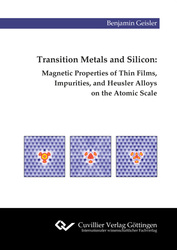| Departments | |
|---|---|
| Book Series (96) |
1378
|
| Nachhaltigkeit |
3
|
| Gesundheitswesen |
1
|
| Humanities |
2364
|
| Natural Sciences |
5406
|
| Mathematics | 229 |
| Informatics | 319 |
| Physics | 980 |
| Chemistry | 1363 |
| Geosciences | 131 |
| Human medicine | 243 |
| Stomatology | 10 |
| Veterinary medicine | 108 |
| Pharmacy | 147 |
| Biology | 835 |
| Biochemistry, molecular biology, gene technology | 121 |
| Biophysics | 25 |
| Domestic and nutritional science | 45 |
| Agricultural science | 1004 |
| Forest science | 201 |
| Horticultural science | 20 |
| Environmental research, ecology and landscape conservation | 148 |
| Engineering |
1793
|
| Common |
98
|
|
Leitlinien Unfallchirurgie
5. Auflage bestellen |
|
Advanced Search
Transition Metals and Silicon (English shop)
Magnetic Properties of Thin Films, Impurities, and Heusler Alloys on the Atomic Scale
Benjamin Geisler (Author)Preview
Table of Contents, PDF (48 KB)
Extract, PDF (170 KB)
The present, richly illustrated book takes the reader on a tour through the field of modern spintronics, discussing key aspects such as ferromagnetic thin films, dilute magnetic semiconductors, and magnetic tunnel junctions. It demonstrates different approaches to a detailed understanding of magnetism and materials properties on the atomic scale, as required by the ongoing miniaturization of electronics. Due to their technological relevance, the focus lies on silicon and different transition metals like chromium, manganese, and iron.
Among others, the following questions are addressed from the viewpoint of state-of-the-art computational physics: Is the scanning tunneling microscope capable of resolving even complex film atomic structures? How can we use its spin-sensitive form to gain insight into interactions of magnetic impurities in bulk semiconductors? Why is chromium-doped silicon especially interesting? Does one need a Seebeck coefficient to obtain spincaloric properties ab initio?
| ISBN-13 (Hard Copy) | 9783954049448 |
| ISBN-13 (eBook) | 9783736949447 |
| Final Book Format | B5 |
| Language | English |
| Page Number | 236 |
| Lamination of Cover | glossy |
| Edition | 1. Aufl. Hardcover |
| Publication Place | Göttingen |
| Place of Dissertation | Duisburg-Essen |
| Publication Date | 2015-03-12 |
| General Categorization | Dissertation |
| Departments |
Physics
Physics of condensed matter (including physics of solid bodies, optics) |
| Keywords | magnetism, silicon, transition metals, silicides, Heusler alloys, spin-polarized scanning tunneling microscopy, density functional theory, hybrid functionals, electronic correlations, spintronics, spincalorics, surfaces, interfaces, thin films, dilute magnetic semiconductors, impurity clusters, magnetic organic molecules, magnetic tunnel junctions |








